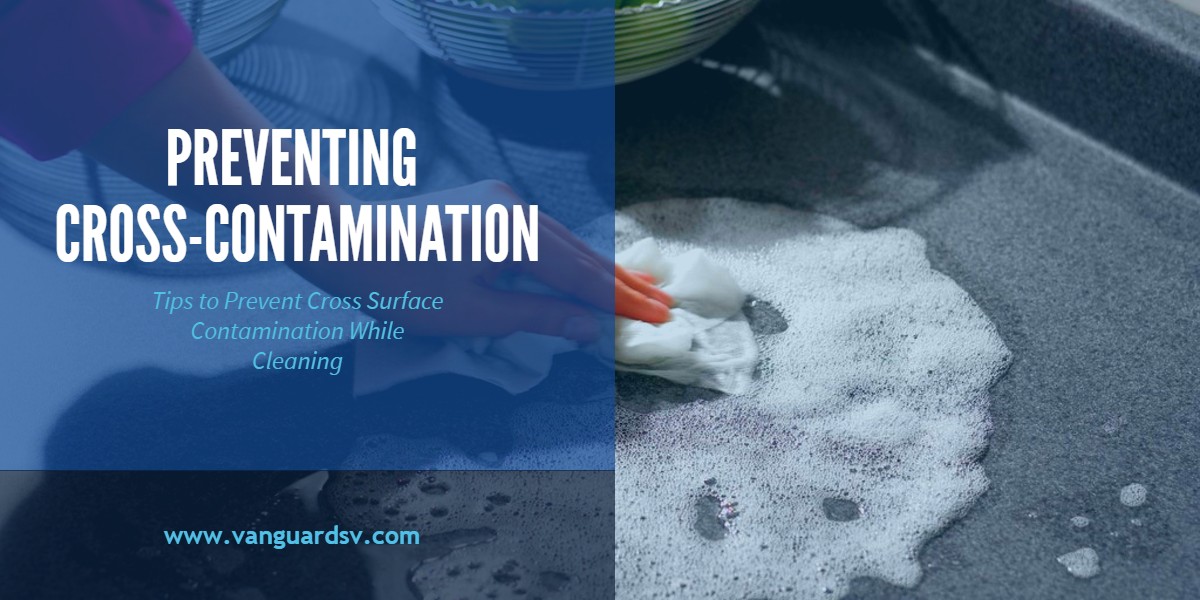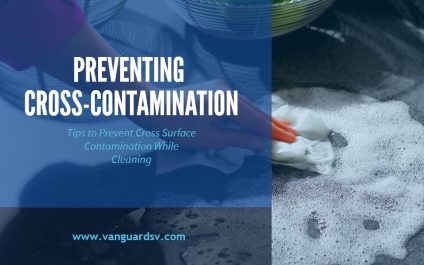Professional janitorial services vendors, specializing in sustainable green cleaning practices, have developed a simple, cost-effective method for preventing surface cross-contamination.

Professional Janitorial Services Tips to Prevent Surface Cross-Contamination
Cross-contamination of surfaces is an issue that plagues schools, homes, businesses, restaurants, and healthcare facilities--occurring when a soiled/contaminated rag, mop head, or towel is used to clean a secondary surface, thereby transferring germs, dirt, bacteria, and other microbial matter from one surface to another via the cleaning apparatus.
Depending on the environment, cross-surface contamination can lead to serious illness and even death--the two most common examples being Healthcare-Associated Infections (HAI), and foodborne illness.
According to the U.S. Centers for Disease Control and Prevention (CDC);
Each year, 1 in 6 Americans gets sick by consuming contaminated foods or beverages.
Many different disease-causing microbes, or pathogens, can contaminate foods, so there are many different foodborne infections.
In addition, poisonous chemicals, or other harmful substances can cause foodborne diseases if they are present in food.
CDC estimates that each year roughly 48 million people gets sick from a foodborne illness, 128,000 are hospitalized, and 3,000 die.
Pertaining to HAI, the CDC reported that;
In 2002, the estimated number of HAIs in U.S. hospitals, adjusted to include federal facilities, was approximately 1.7 million: 33,269 HAIs among newborns in high-risk nurseries, 19,059 among newborns in well-baby nurseries, 417,946 among adults and children in ICUs, and 1,266,851 among adults and children outside of ICUs. The estimated deaths associated with HAIs in U.S. hospitals were 98,987: of these, 35,967 were for pneumonia, 30,665 for bloodstream infections, 13,088 for urinary tract infections, 8,205 for surgical site infections, and 11,062 for infections of other sites.
Estimating Health Care-Associated Infections and Deaths in U.S. Hospitals, 2002
Key Areas of Concern
Regardless of industry, cross-contamination is an issue where individuals come into contact with a contaminated surface, that likely has not been subjected to recommended levels of sanitation, and then contacts a separate surface without observing proper hand or equipment sanitation practices.
The chief areas of concern in hospitals are:
- Diagnostic equipment.
- Medical tape.
- Patient charts and medical records.
- Patient environment, including the bed, as well as the fame and rails, the bedside table and other furniture, and the patient clothing.
- Computer keyboards.
- Crash carts and procedure trays.
- Sterile Processing and surgical instruments, and;
- Hospital kitchens.
Source:
In restaurants and homes:
- Food preparation areas, and;
- Eating surfaces and utensils.
Source:
And in schools:
- Shared workstations.
- Eating surfaces.
- Drinking fountains.
- Countertops.
- Keyboards, mice, and mobile equipment, and;
- Communal toys and outdoor equipment.
Source:
Green Cleaning Tips for Cross-Contamination Prevention
Cost-effective prevention of cross-surface contamination is a relatively simple process.
- Color-code and categorize your microfiber towels, mops, and brooms for specific areas and surfaces. For example, use red to sanitize restroom floors and urinals, and yellow to sanitize horizontal and vertical surfaces, as well as fixtures.
- Use the Two-Bucket Cleaning Method--comprising of one bucket, containing a mixture of water and diluted cleaning product, and a second bucket to ring out mops and rags in. This method serves the dual purpose of reducing the introduction of dirty or contaminated water into the cleaning solution, as well as water waste.
- Clean from top to bottom. This approach eliminates the introduction of contaminants to already cleaned surfaces, especially those emanating from light fixtures and fans. Always clean the floor last to remove dirt, dust, and other particulate matter that was present, or dislodged during the previous stages of the cleaning process.
- Clean first, then disinfect. Certified cleaning products are meant to remove dirt, oil, and grease, but are not suitable for sanitation or disinfection. Conversely, sanitation and disinfection products make poor cleaners, and their efficacy is significantly reduced by the presence of dirt and other, non-bacterial microbial buildup.
- Use as few people as necessary to clean a designated space or, better yet, assign a specific team member to each space to clean and disinfect, from top to bottom, to further reduce potential cross-contamination between rooms.
- Implement proactive and touchless disinfection systems, such as UV lighting and electrostatic cleaning systems, especially for OR's and surgery centers, to further eliminate germs and bacteria while completely avoiding cross-contamination by way of cleaning rags.
- Switch all cleaning products that your organization is allowed to switch, to a certified green cleaning product to avoid the cross-contamination of surfaces and food with highly-toxic chemicals.
Human behavior is also a significant contributor to cross-contamination challenges.
- Proper hand-hygiene, especially among food handlers, doctors and nurses, and children could eliminate the vast majority of preventable cross-contamination illnesses, hospitalizations, and death. Scrub your hands with liquid-foaming soap for 45 seconds, making sure to get in between fingers, as well as under fingernails.
- Prepare all food according to recommended guidelines, and avoid washing raw meats and poultry--it does nothing to remove bacteria, and will likely spread germs to other surfaces and food stuff.
- Clean up spills immediately with a microfiber product, and sanitize with a certified green cleaning wipe, making sure to note to the janitorial staff that specific areas may require extra attention.
References & Resources
- Cross Contamination
- Hospital hygiene and infection control
- How to Prevent Cross-Contamination
- Preventing Cross-Contamination Is as Easy as 1, 2, 3
Takeaway
Preventable illness acquired through surface cross-contamination during the cleaning and disinfection process costs U.S. tax payers hundreds of millions of dollars per year in healthcare costs, lost work and school days, and reduced student and worker performance.
Even worse is the unnecessary and entirely preventable death toll.
If you would like to learn more about the advantages of outsourced janitorial services and sustainable green cleaning practices to eliminate surface cross-contamination, contact us today for a free quote!
In Bakersfield CA, call (661) 437-3253
In Fresno CA, call (559) 206-1059
In Valencia CA, or Santa Clarita CA, call (661) 437-3253

